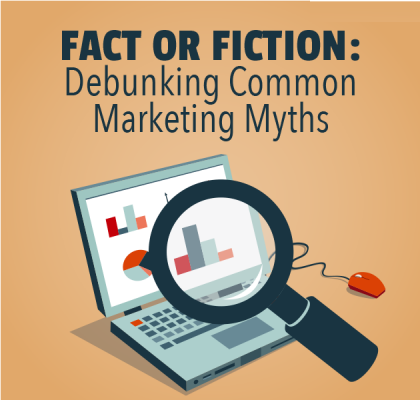It’s no secret that effective marketing is key to an enterprise’s growth, but there are many marketing secrets that are buried beneath a mythical façade. As the internet introduced many new marketing channels, it also fostered many new marketing misconceptions.
Follow along as we try to debunk these myths and find the truths that lie beneath them.
Myth 1: The No. 1 Goal of Marketing Is Acquiring New Customers
A common marketing misconception is that a new company’s focus should always be on landing new customers. While increasing your customer base is always important, studies show that marketers should shift focus away from customer acquisition in favor of customer retention.
FiveStars Loyalty, Inc., recently conducted a study that compared stats about customer acquisition and customer retention. It found that while the majority of marketers (63%) think acquisition is of the utmost importance, your returning and loyal customers actually drive a significantly higher amount of revenue, despite representing a smaller share of your customer base.
The study calculated that loyal customers (those that have visited your business at least 10 times) account for only about 20% of your total customers, but that 20% makes up about 80% of your revenue and 72% of the total visits to your business. It found that while the probability of making a sale to a brand-new customer hovers anywhere between 5 and 20%, the probability of making an additional sale or upsell to loyal customers is around 60 to 70%. In the most telling stat of all, the study found that loyal customers have 10-times more lifetime value than new customers.
For completely new businesses, the sole focus should be landing customers, but once those customers start flocking, don’t completely neglect them. Devise a strategy to engage with customers after their purchases are made. You can:
- Send out emails thanking them for their visit, offering them tips for making the most of their purchase and highlighting products related to their purchase.
- Offer small rewards for their participation in surveys asking about their visit.
- Direct them to your blog, or encourage them to join your social media community.
- Offer special discounts and coupons for return customers as part of a loyalty program.
- Devise another creative reward within your budget that will remind customers of the benefits of doing business with your brand.
Create loyal customers out of new ones, and focus efforts on keeping them happy. The referrals and word-of-mouth advertising may just go a lot further than that customer acquisition strategy you were planning on rolling out.
Myth 2: Clever, Eye-Catching Creative Is the Most Effective Form of Marketing
As this year’s Super Bowl came and went, business buzz surrounding the event was focused mainly on advertising. The outrageous prices for a 30-second spot led observers to question the effectiveness of spending that much cash on advertising. When people highlight the best ads of the Super Bowl, focus is typically given to clever copy and creative visuals, but recent studies show that might not be the most effective form of marketing.
In fact, as B2B Technology Marketing Community recently discovered, the most effective form of content marketing is probably the least flashy: customer testimonials. The study asked marketers to characterize media as either “effective” or “ineffective” marketing channels. Those receiving the highest scores were customer testimonials, case studies and in-person events.
Another study found that 70% of consumers don’t accept advertising as truth; they do, however, trust and value the thoughts of their peers. The study found that 63% of social media users feel consumer ratings are the best sources for product information. It also found that 90% of people believe brand recommendations from friends, while 70% believe consumer ratings. Respondents also had a 71% likelihood of making a purchase when referred by social media.
While this might be a surprising find, it’s also great news for small businesses.
Building and managing a creative team of copywriters and designers is costly and time-consuming, but as these highlighted reports show, small businesses should avoid a focus on the creative. Instead, establishing a greater social media presence that encourages and allows consumer interaction and engagement can be a great place to focus marketing efforts. Conducting simple surveys of your customers and highlighting positive responses on your site can also be an effective yet inexpensive marketing strategy.
Either way, for small business owners struggling with tight marketing budgets, there are plenty of cost-efficient ways to maximize returns on your marketing investments.
Myth 3: The More Emails You Send, the More Customers Ignore Them
While the aforementioned studies confirm the widely held belief that consumers don’t trust advertisements, that doesn’t necessarily mean they don’t pay attention to them. A quick YouTube search will result in many commercials recorded and uploaded by brand advocates and viewed by hundreds of thousands of users, ads that consumers actually went out of their ways to view. And just as people enjoy commercials from their favorite brands, there are plenty who anticipate the weekly mailers filled with coupons sent to their houses.
So why is it assumed that email marketing blasts are any different?
The truth is that some advertising benefits consumers, and the more they’re exposed to that beneficial marketing, the more open they’ll be to take advantage of it. Email marketing is also different from traditional media, as many consumers actually sign up to receive the newsletters, meaning they’re expected and even sometimes welcomed by subscribers.
So while the belief is that more emails translate to more ignores or poorer metrics, the truth is actually the opposite. Email marketing agency Alchemy Worx reports that when marketers increase the amount of weekly email sends, the number of consumers who open one or more emails actually doubles, which significantly increases revenue.
This doesn’t mean you should flood inboxes with a deluge of emails, but you also shouldn’t hesitate to send a couple messages per week, as long as each of those emails can provide value to the customer. Segmenting your market to allow for more personalized messages has shown to increase the effectiveness of email marketing, so mix up your generic blasts with a couple that are geared toward a geographic segment or a consumer group that bought a specific product. Get creative with your efforts, and try different subject lines, different content, copy, visuals, etc. Test everything, and focus efforts on what proves effective.
The real truth is that what works for some businesses won’t work for everyone. Those who blindly follow the advice of others are responsible for perpetuating outdated marketing myths, so remember to take all marketing “truisms,” including the ones highlighted above, with a grain of salt. Take some time to understand your brand and your customer base, and use the findings here to personalize your own marketing efforts to see a greater return on your dollar.




